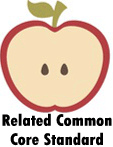Comparing Dialects and Registers of English Worksheets
Related ELA Standard: L.5.3.B

We often think of English as a set language based on where we are located, but English has many different forms. In fact, there are thought to be over one-hundred and fifty different dialects. A dialect is a social or geographically acceptable form of word pronunciation, grammar, and syntax. It can even go a bit further as to how a language speaker feels or internally predicts language that is appropriate to the region they are communicating with. This series of worksheets help learner realize the expected dialect or register that is expected of their speech patterns.
Dialects and Registers Worksheets To Print:
Dialect
and Voice – Read the passage. Then use the cluster diagram to
identify the dialect and voice of each character.
Identifying
Registers – Read each line of dialogue below. Sort them according
to the level of formality of the setting and the relationship of the
characters.
Dialect
| Accent – The sentences below are from Thomas Hardy's novel
Tess of D'Urbervilles. Read each sentence. Does it convey accent,
dialect, or both?
Be the
Editor – You are the editor of the school newspaper, and you
gave three different reporters the same assignment: report the results
of the school Spelling Bee.
Understanding
Registers – For each scenario provided below, choose the register
of speech that is the most appropriate.
The Pink
Planet – The goal of the narrative voice in literature is to
speak in a way that is consistent with the reality it illustrates.
Register
– Read each snippet of dialogue below. Is the register of the response
appropriate to the register of the question?
How to Compare Dialects and Registers of English?
English is one single language, but the number of its dialects is uncountable. Every other day, a new regional dialect or register of the English language is reported to be found and is considered an official variety of the English language. Due to its status as the official language for communication across the world and a large number of people speaking it for various purposes, the number of dialects of the English language is only increasing.
Comparing and contrasting various dialects and registers of the English language like American English, British English, Australian English, Canadian English, Irish English, and others is an art which many master perfectly. Here are some ways in which these different dialects and registers can be compared and contrasted:
Comparing Words and Meanings
The English words spoken in different parts of the world have different meanings and uses. Learning more and more about the vocabulary uses in different English registers and dialects can easily assist one in comparing one dialect with another and marking which one is which. For example, the front part of the car is known as hood, bonnet, chapeau, lid, and has many other names depending on the area where it being spoken. Moreover, one single word can have different meanings in different dialects and comparing those can give a good difference between the dialects and registers of different regions.
Comparing Pronunciation
Spoken accents are always a great way to compare, contrast, and mark different dialects and registers of the same language. The stress on some sounds while the omission of other, specific ways of producing one phoneme, and other such differences are easily evident in the speakers of two different dialects being compared.
Comparing Grammar and Written Forms
Different dialects and registers of the same language follow different grammatical patterns and have different spellings and other written elements which can be contrasted easily.

